Office Cubicles
Cubicle Systems, Walls, and Workstations Designed for the Modern Office
Think of your office cubicle as your office cockpit where everything you need is an arm’s length away; office tools are within reach, helping to make your work flow fluent, efficient, and more productive. Office cubicles come in a variety of sizes to fit your floor plan. We can help with your design, layouts, project management, delivery and installation.
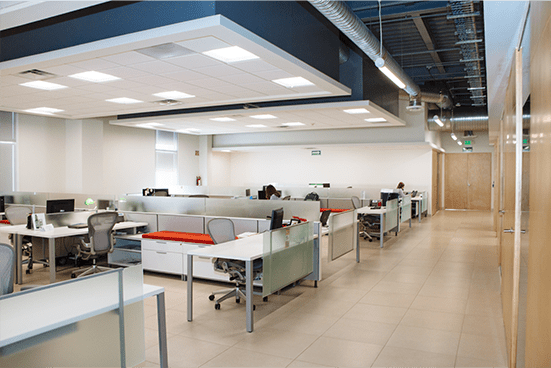
Shop Cubicles
-
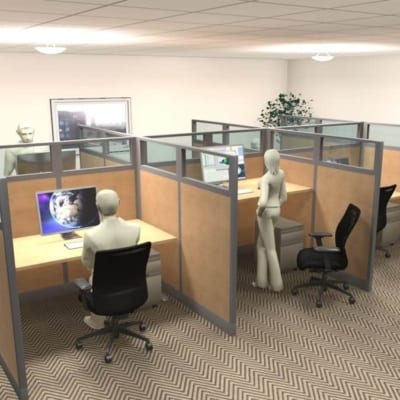
6 Person Laminate and Glass Workstation #202
$ 16,398.00 -
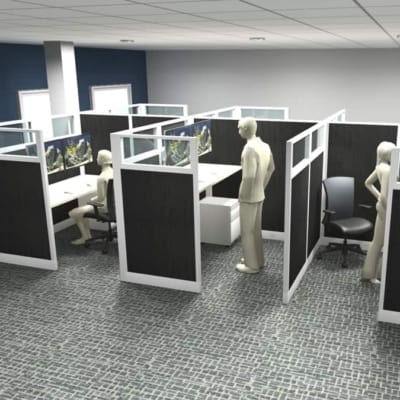
6 Person Laminate Workstation #204
$ 19,056.00 -
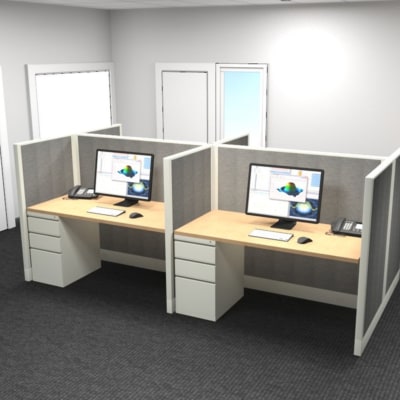
4-pack Workstation with Powered Panels #210
$ 4,125.00 -
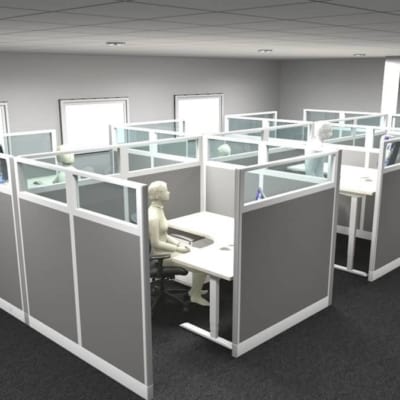
6×8 Laminate Workstations #205
$ 25,398.00 -
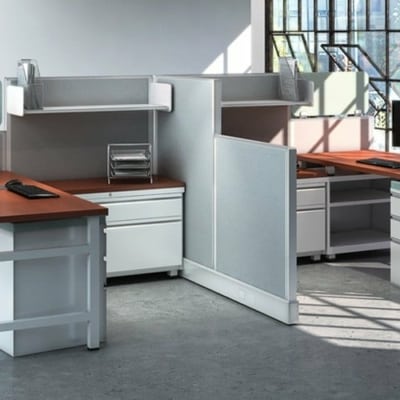
Open Style Cubicle Workstations #211
$ 5,760.00 -
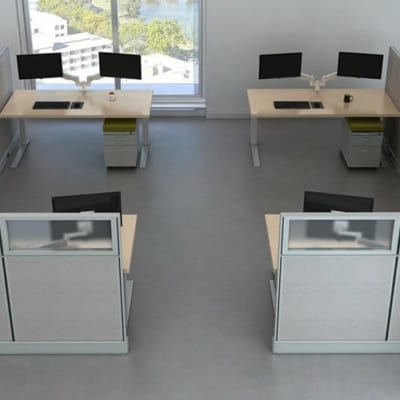
4 Person Collaborative Bullpen #215
$ 9,794.00 -
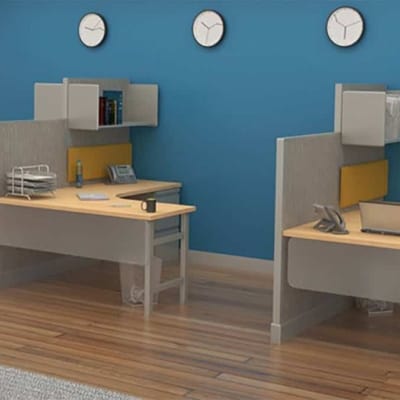
Semi-Private High-Low Cubicle #217
$ 4,319.00 -
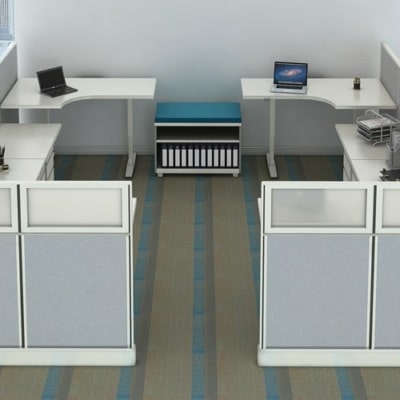
4 Person Sit-Stand Bullpen #219
$ 9,500.00 -
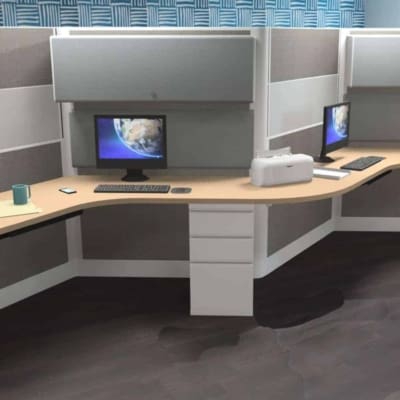
2 Person 120 Degree Workstation #221
$ 4,440.00 -
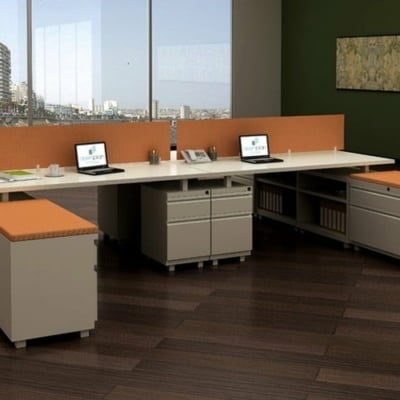
4 Person Open Workstation #223
$ 6,836.00 -
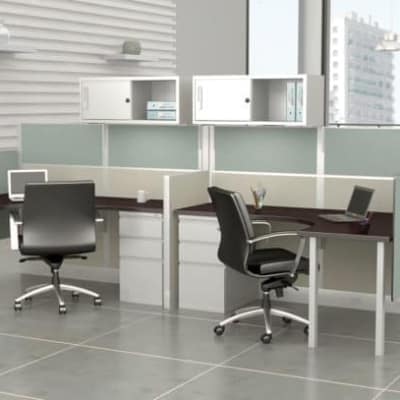
2 Person Open Style Cubicle #224
$ 4,336.00 -
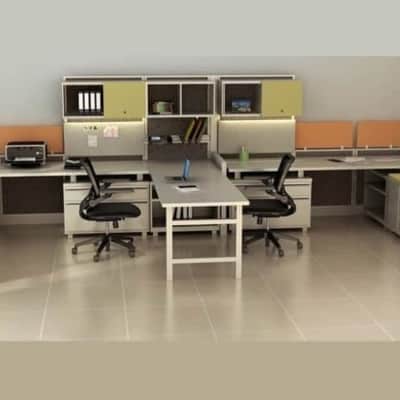
Open Style Cubicle Workstations #227
$ 9,392.00 -
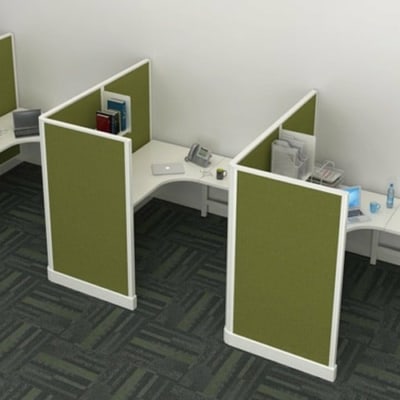
Modern Cubicles with Privacy Panels #229
$ 5,085.00 -
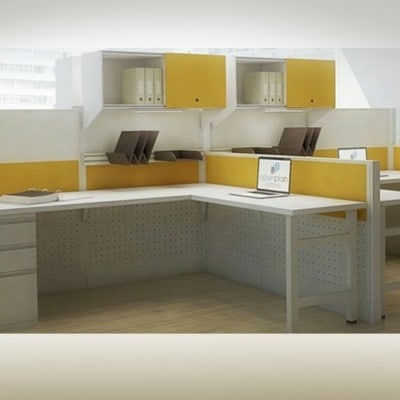 $ 9,591.00
$ 9,591.00 -
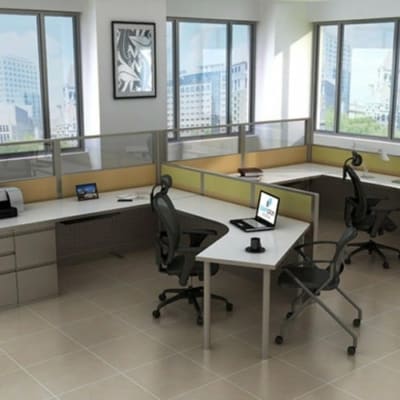
120 Degree Open Style Cubicles #235
$ 6,898.00 -
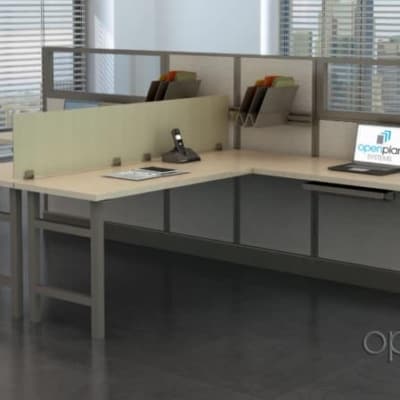
2 Person Collaborative Cubicle #237
$ 3,114.00 -
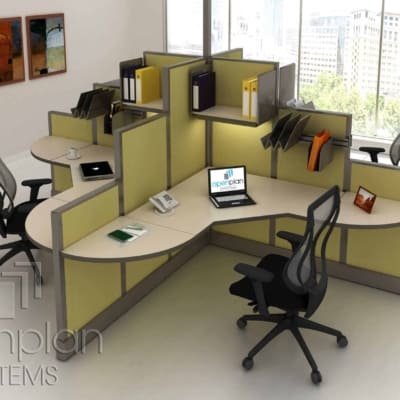
Clover 4 Person Workstation #239
$ 5,123.00 -
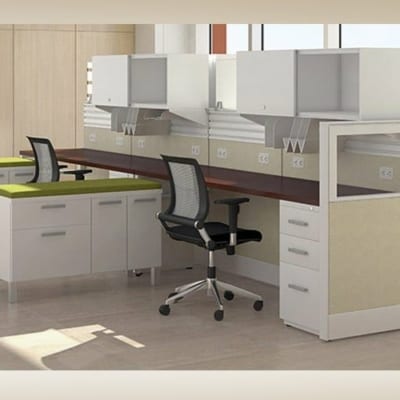 $ 9,529.00
$ 9,529.00 -
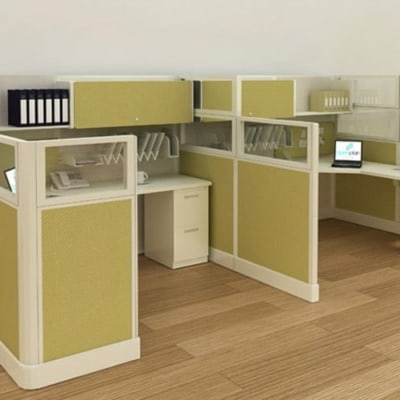 $ 7,489.00
$ 7,489.00 -
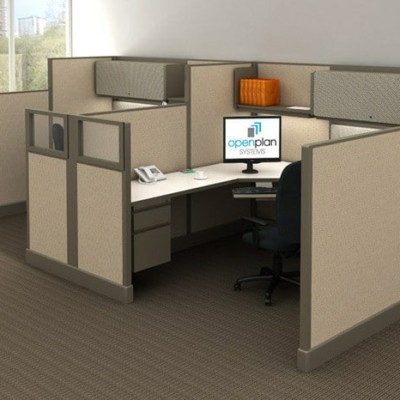
High-Low Cubicle Style Workstations #250
$ 6,166.00 -
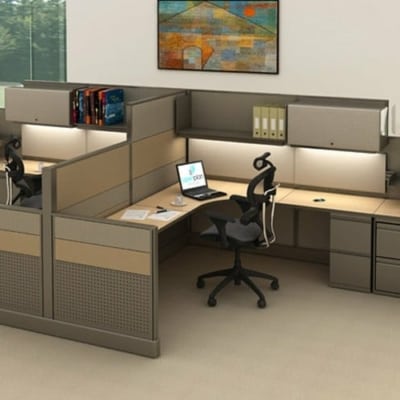 $ 8,861.00
$ 8,861.00 -
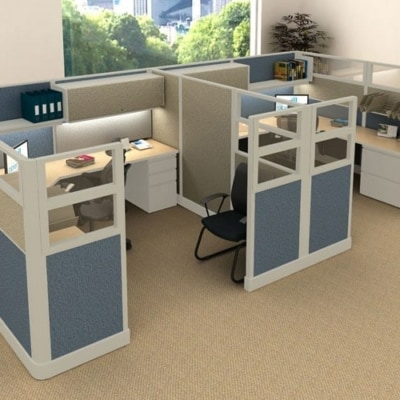
Partial Glass High Paneled Cubicles #258
$ 10,513.00 -
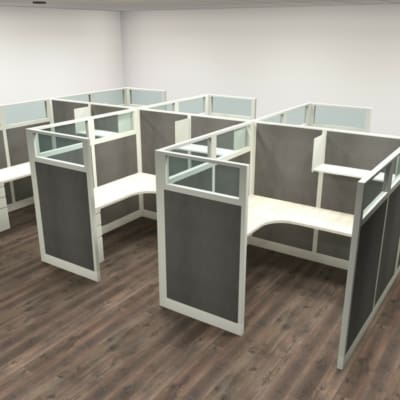
6 Pack Fabric and Glass Workstation #265
$ 14,595.00 -
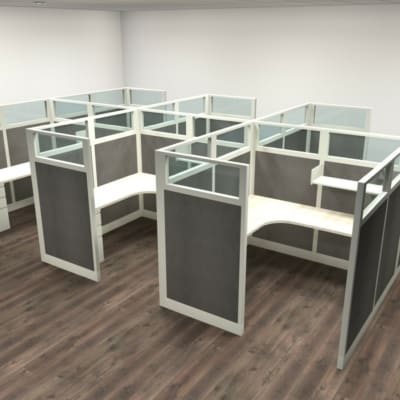
6 Person Fabric and Glass Workstation #269
$ 15,288.00 -

6 Pack 6x6x67H Workstation with Fabric Panels #271
$ 12,081.00 -
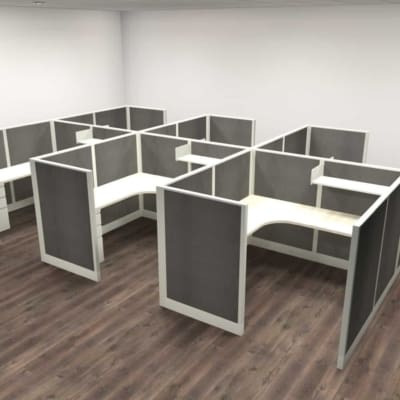
6 Pack 6x6x53H Workstation with Fabric Panels #275
$ 11,161.00 -
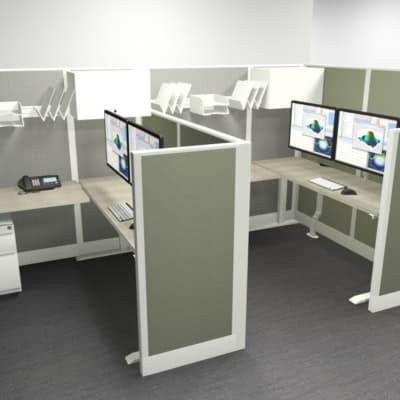
Hybrid Height Adjustable 2-pack Workstation #261
$ 6,800.00 -
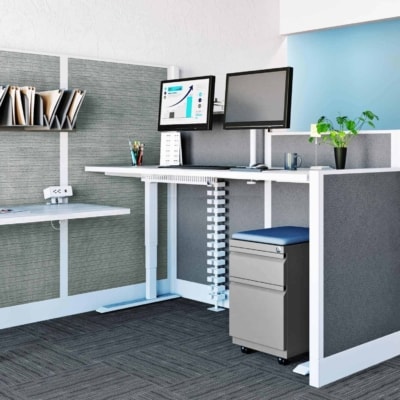
Hybrid Height Adjustable Workstation #145
$ 3,689.00 -
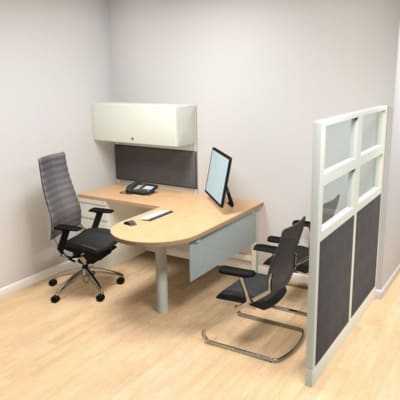 $ 2,365.00
$ 2,365.00 -
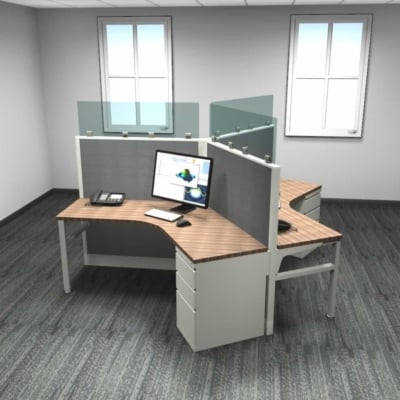
3 Person 120 Degree Workstation with Panels #146
$ 3,646.00
Office Cubicles Buyer’s Guide
What is a Cubicle?
A cubicle is a piece of office furniture consisting of multiple panels that form a small, individual workstation. Cubicles create a more efficient workplace by grouping workers together in a space that allows for more collaboration and privacy. They were introduced in the late 1960s as part of that time period’s modern office design. There are pros and cons to using cubicles to design an office instead of other office layouts and furniture.
Let’s take a closer look at the history of cubicles and why they are used today.
Why Cubicles?
There are many reasons why cubicles are used in offices today. One often-cited reason is that they are more cost-effective than other types of office furniture. Cubicles can also be reconfigured easily to change the layout of an office, which makes them ideal for businesses that are growing or changing constantly. Cubicles provide privacy for employees, which can increase productivity.
History of the Cubicle
Do you know the history of the cubicle? The cubicle was invented in 1964 by Robert Propst. At the time, Propst worked for the Herman Miller Furniture Company. During his time there, he studied how his colleagues worked and sought to improve the open-bullpen office space. Propst designed the “Action Office,” which was adjustable to varying heights for employees who wanted to stand while they worked.
The Action Office included a large desk, space for phones, a vertical filing system, and partitions so workers would have a more private workspace away from their colleagues. Propst believed that the adjustable desk would help workers with health-related issues, by improving blood flow, for example. He also thought that employees could be more productive if they had their own private spaces and could spread out their work.
Unfortunately, cubicle sales flopped back in 1968 and the idea never took off. The original design was too large and expensive for corporate America. Propst’s design mixed movement and flexibility; his cubicle was dynamic and designed for both privacy and collaboration with colleagues. Through the 1970s and 1980s, the Action Office idea caught on, but it went through radical changes, eventually becoming the cubicle of today.
Despite the recent popularity of open floor plans, a study from Harvard Business School found that employees communicate less in an open floor plan. Although approximately 70% of employers today are still using an open floor plan, many find that the lack of barriers has adverse effects on employee productivity.
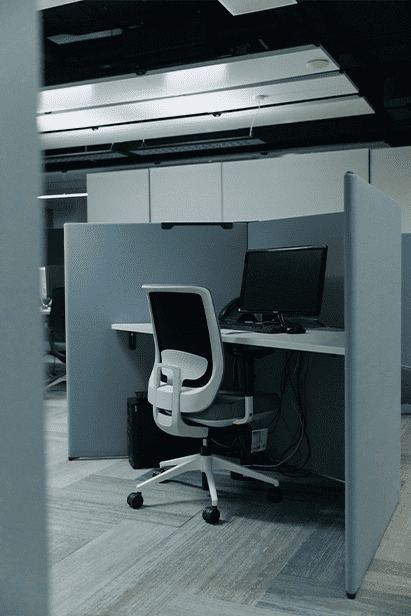
Freestanding vs. Panel-mounted Cubicles
There are two main cubicle types: Freestanding and Panel-mounted. Freestanding cubicles are not attached to any walls, while panel-mounted cubicles are connected to one or more walls. Freestanding systems use separate panels and place them around individual workstation components such as desks, chairs, and filing cabinets.
Panel-mounted cubicles are generally more expensive than freestanding cubicles. Desks, filing cabinets, and other necessary components are built into the panels. Most office cubicle designs start with panel-mounted systems. There are many different types of panel-mounted cubicles, and each has its advantages and disadvantages.
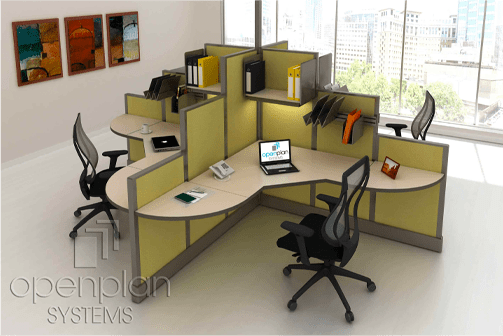
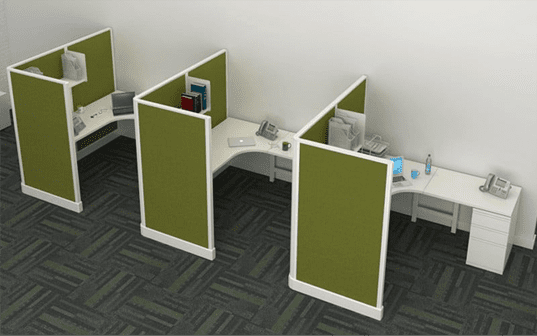
Types of Cubicles
Not all cubicles look the same or fulfill the same functions. For example, some cubicles are designed for mutual collaboration and others maximize office space and efficiency.
Open

Open cubicles encourage collaboration and communication among employees. They have low walls so that employees can see and talk to each other easily. These open cubicles are the most flexible type of cubicle, as they can be reconfigured quickly and easily to accommodate changes in the workplace. However, they offer the least amount of privacy and can be noisy.
High-Wall
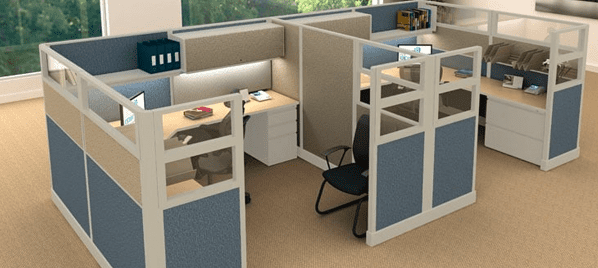
High-wall cubicles are the opposite of open cubicles; they have high walls that provide privacy and noise reduction. These cubicles are ideal for employees who need to concentrate on their work and do not want to be disturbed. However, high-wall cubicles can make it difficult to see and talk to other employees.
Low-Wall
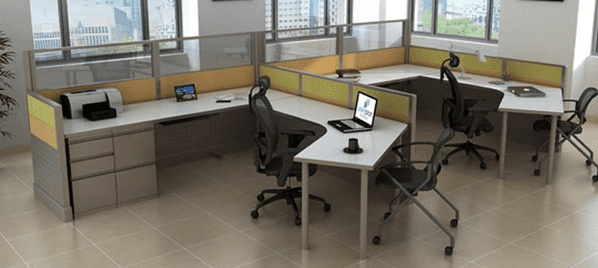
Low-wall cubicles are a compromise between open and high-wall cubicles. They have tall enough walls to provide some privacy but walls that are not so high that they block sight lines and make it difficult to talk to other employees. Low-wall cubicles are more flexible than high-wall cubicles but not as flexible as open ones.
Circular

These cubicles are a modern, more stylish addition to the workplace. They are designed to encourage collaboration and communication and they can be reconfigured easily. Circular cubicles also create the illusion that the room is more spacious, which may improve mood and encourage innovation. However, they offer the least amount of privacy and are not efficient in terms of space, which may hinder workflow.
L-Shaped
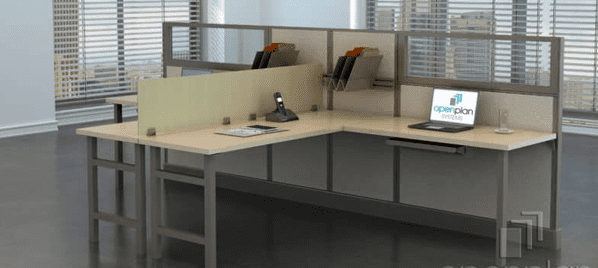
L-shaped cubicles maximize office space and efficiency; they have two walls that offer privacy and reduce noise and they are budget-friendly. These cubicles are also more stylish than traditional rectangular cubicles and they come in long or short designs. However, L-shaped cubicles can be difficult to reconfigure.
Professional / Standard
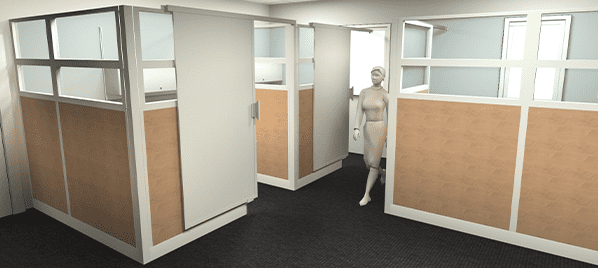
Professional or standard cubicles are available in various sizes and provide privacy and noise reduction. The primary advantages of these cubicles are that they are customizable and can combine unique designs. Professional or standard cubicles can be customized to suit employee needs, which often vary based on the type of business. The disadvantages are that they can be more expensive than others and may not be as flexible in reconfiguration.
Call Center
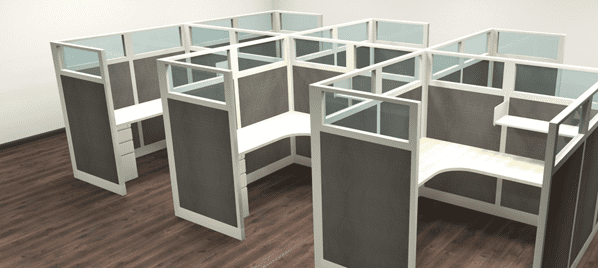
Call-center cubicles are for employees who spend most of their days on the phone. They are taller than standard cubicles to provide more privacy and noise reduction. They also have a built-in shelf for documents and a headset hanger.
Modular
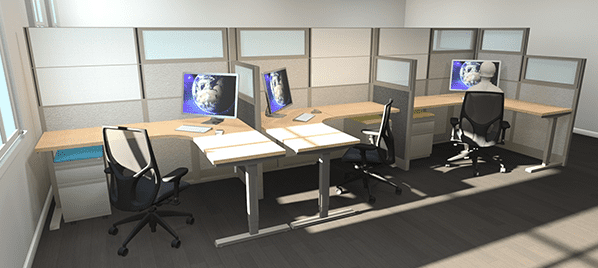
Modular cubicles are like standard cubicles but with more flexibility for custom configuration. They are ideal for growing businesses or in an industry with a lot of seasonality or turnover. Their layout or configuration can be expanded, reduced, or changed easily.
Common Cubicle Layouts
Employers have multiple factors to consider in deciding how to lay out an office and cubicle areas. From creating a productive and welcoming workplace to maintaining a safe environment during a pandemic, the role that cubicle layouts play in office design is more critical than ever.
In cubicle design and layout, options and decisions must be considered carefully. Each layout impacts traffic flow and productivity differently. The most common cubicle layouts are described here:
Bullpen
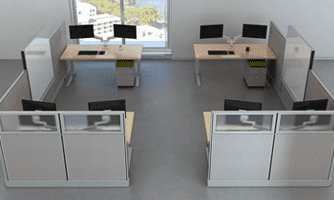
A bullpen is an open floor setup where employees work at separate cubicles or “workstations” but where there are no partitions or offices to offer privacy. Many government agencies and offices in the public sector use bullpen layouts. Employees have easy access to each other for questions, which is an advantage. Unfortunately, this layout can create a distracting environment and may not offer the option for social distancing among colleagues.
Cluster

This layout groups employees into teams or departments. Each cluster has cubicles or workstations and there may also be a few shared meeting rooms or common areas. This layout promotes collaboration and team-building. However, it can be distracting if teams are too close together.
Straight Run
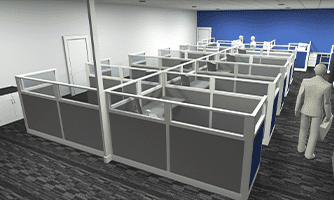
A straight run, where rows and columns of identical cubicles are organized in a grid, is the most traditional cubicle layout. This layout is easy to navigate and makes it simple to locate specific employees. A straight-run configuration is also cost-effective since it does not require a lot of furniture or decor. However, this layout often does not look as trendy and visually pleasing as some other options.
3-Person Workstation

A 3-person workstation allows 3 people to work at the same desking unit, but each has separate space for working, like a traditional cubicle. Typically, these workstations have panels or screens that separate employees. This configuration allows for easy collaboration and for grouping teams into 3-person pods.
Standing Desk
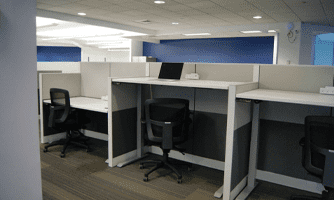
Standing desks or height-adjustable cubicles allow employees to choose to sit or stand at their workstations throughout the day. Not only is this a healthier work environment for employees, but a standing desk can be an added perk that attracts new talent to your team.
Private Office / Enclosed
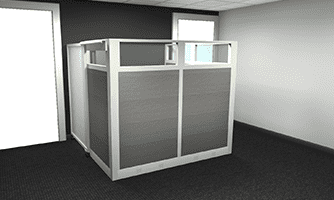
A private or enclosed office cubicle is a layout where each station has four walls and a door. This layout offers the most privacy and helps minimize sound and distractions. However, it is also the most expensive option and requires the most space. Efficient collaboration and group work are more challenging with enclosed or private office configurations.
Cubicles and Office Design
As businesses and workplaces continue to change, so does office and cubicle design. Employers are increasingly focused on creating a productive and welcoming workplace for employees. They are also concerned about maintaining a safe environment during a pandemic. Over the past decade, companies have abandoned cubicles for an open office layout and then shifted back in favor of cubicles again.
Since their inception, cubicles have been designed to help employees focus on task completion. A task-oriented setup is usually more efficient for individual work. However, when the goal is to promote productivity, cubicles may not always be the best option. The installation and use of resimercial furnishings and collaborative pieces have increased, as they establish more relaxed and comfortable settings.
These changes demonstrate that the cubicle has a time and place in the office. Open-concept layouts are more conducive to teamwork, but they do not promote the same level of focus that cubicles do. When a business is considering cubicles, the first thought should be for the overall office design. Next would be the decisions about how cubicles fit in and what roles they play. Design goals help determine other aspects of cubicle purchases: sizing, accessories, door and power options, storage capacity, maintenance needs, and delivery and installation lead times.
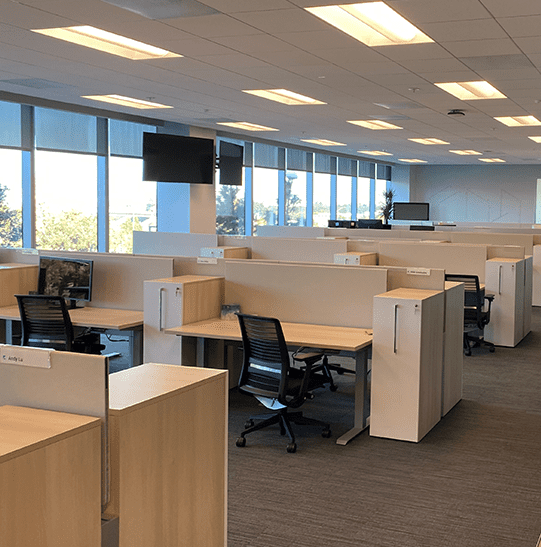
Cubicle Sizing
The most common cubicle sizes are 6′ x 6′, 6’ x 7’, 6′ x 8′, 7’ x 7’, and 8′ x 8′. However, other sizes are available, depending on the needs of the business. When you know the amount of space available for cubicles, and how many employees you need to accommodate, you can decide on the optimal cubicle size.
Helpful Cubicle Accessories
Cubicles can be highly customizable, but businesses may not know where to start. An excellent starting point is with the basics, such as partitions, overhead bins, and shelves. These accessories create a more organized and efficient workspace. Other popular accessories include monitor arms, CPU holders, and keyboard trays. Again, these accessories create a more ergonomic workspace.
Cubicle Doors
Cubicles with doors can offer higher levels of privacy and noise reduction. They can also present a professional appearance. Doors are popular options when a hybrid of a cubicle and a private office is needed, but it is not realistic to have private offices for everyone. When employees spend significant amounts of time on the phone, enclosed cubicles with a door are a suitable option.
Cubicle Power
As cubicles need access to power, power sourcing must be a consideration in planning and designing an office. How will power get to a group of cubes and from cube to cube? Providing power is easiest when cubicles are connected to each other and when the group of cubicles is connected to a wall or another power source.
Storage Capacity
In selecting cubicles, it is important to consider storage capacity; this is especially true for businesses with significant quantities of files and documents. Cubicles with shelves, overhead bins, and file cabinets provide storage space. Employers may need to consult with a manufacturer to determine the best storage options available for their cubicle designs.
Maintenance Needs
Another important consideration for businesses is maintenance. Cubicles are available in various materials, but some require more maintenance than others. For example, fabric cubicles may need to be replaced more frequently than cubicles made from steel or aluminum. Businesses should also consider the amount of time and effort required to keep cubicles clean. Cleaning maintenance tasks such as controlling dust, reducing allergens, and removing stains help equipment last longer.
Delivery and Installation Lead Times
Businesses should consider carefully delivery and installation lead times, as those times can impact a new office build-out or redesign. Office construction project delays can affect the budget and prevent an office from opening on time. There are currently longer lead times than usual for most office furniture products; installation team availability is also a challenge. Be sure to plan ahead to avoid delays.
Frequently Asked Questions
What is the difference between Benching and Cubicles?
As a general overview, cubicles are panel-based workstations that provide the most privacy from other employees; benching has either no or minimal panels and provides an open-style row of desks meant to encourage collaboration.
Cubicles can come in many sizes and configurations depending on the client’s needs. Panels come in 39″, 47″, 53″, 67″, and 85″ heights, comprised of fabric, glass, and whiteboard finishes.
Benching or desking is typically used in smaller workspace configurations and can measure anywhere from 3′ to 7′. If privacy is needed, privacy screens with heights of 8″ to 24″ can be added.
What is a Privacy Screen?
Privacy screens (also known as privacy panels) are used as dividers between workstations to define boundaries and give employees both privacy and improved acoustics. They can come in fabric, lexan glass, laminate, and whiteboard finishes, and are available in many sizes to fit almost any workstation.
What is the difference between a Power Pole and Base Feed?
Power poles and base feeds are both options for bringing power to your workstations. A power pole is generally used in applications where power and data are being brought down from the ceiling. The power pole can connect directly to the work surfaces or panel system you choose. A base feed, on the other hand, is connected to workstations from the floor or the wall.
What are Sit/Stand or Height Adjustable desks?
As more research has been conducted on the effects of sitting for long hours during the work day, it has been found that over-sitting can have significant negative effects on your health.
As a way of combating these negative effects, height adjustable desks have been introduced as a way for people to stand periodically throughout the work day. They can be programmed at different heights if electronic or pneumatic, or they can be hand-cranked to the height you need.
What is standard cubicle size?
6’ by 6’ is the smallest cubicle size recommended.
What is ergonomic office furniture?
Ergonomic furniture is furniture designed and manufactured to work with the human body. There is also passively designed ergonomic furniture which is designed with less controls.
How should you approach office design for the hybrid workforce?
It is dependent on the philosophy of the company and is taken on a case by case basis. Some companies may want employees to return and have their own desk while others may leave more collaboration space for employees who do not come to the office as often.
Should our office design and furniture be an open layout?
Marketing, sales and creative departments, are typically in a more open and collaborative space
Finance, HR, engineering, and accounting, are typically behind closed doors or at private work spaces
